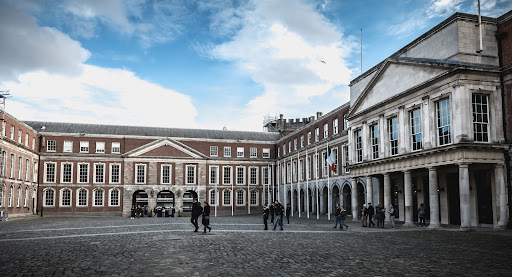Dublin Castle stands as one of Ireland’s most significant historical landmarks, its stone walls bearing witness to centuries of Irish history. Since the formation of An Garda Síochána in 1922, it has served as the administrative headquarters of Ireland’s national police service, becoming the beating heart of Irish policing operations.
Origins and Early History
Long before the Gardaí took residence, Dublin Castle served as the seat of British rule in Ireland for over 700 years. Built in the early 13th century on the orders of King John of England, the castle was initially constructed as a defensive fortification. Over time, it evolved into the administrative centre of English and later British administration in Ireland.
The irony that the symbol of colonial rule would become the headquarters of the police force of an independent Ireland is not lost on historians. This transformation represents the reclaiming of Irish institutions following the Anglo-Irish Treaty of 1921 and the subsequent establishment of the Irish Free State.
Transition to Garda Headquarters
In August 1922, following the handover from the Royal Irish Constabulary (RIC), the newly formed Civic Guard (later renamed An Garda Síochána) established its headquarters in Dublin Castle. The first Commissioner, Michael Staines, oversaw this transition during the tumultuous early days of the Irish Free State.
The symbolism of this transition cannot be overstated. The castle that once represented foreign rule now housed Ireland’s unarmed police force, committed to serving the Irish people through consent rather than coercion. Commissioner Staines famously declared that the Garda would “succeed not by force of arms or numbers, but on their moral authority as servants of the people.”
The Castle Complex
The Garda headquarters occupied several buildings within the castle complex. The most significant was the Treasury Building, which housed the offices of the Commissioner and other senior officers. The Record Tower, one of the few medieval structures remaining from the original castle, eventually became home to the Garda Museum.
Other parts of the complex housed various Garda departments, including detective branches, administrative offices, and communications centres. The castle’s central location in Dublin made it an ideal hub for coordinating policing activities across the country.
Policing Through Troubled Times
From Dublin Castle, the Garda leadership navigated the force through some of Ireland’s most challenging periods. During the Emergency (World War II), the headquarters coordinated national security efforts while Ireland maintained its neutrality. The Troubles, which primarily affected Northern Ireland but had significant security implications for the Republic, saw increased security measures at the castle.
Throughout decades of change, the castle remained a constant in Irish policing, adapting to evolving security challenges while maintaining the core principles of community-based policing that have defined the Garda since its inception.
Modern Era and Phoenix Park Transition
By the late 20th century, the limitations of the historic castle as a modern police headquarters became increasingly apparent. The ageing infrastructure struggled to accommodate modern technology and expanding police operations. In 2008, plans were announced to relocate the Garda headquarters to a purpose-built facility in Phoenix Park.
The move to the new headquarters was completed in 2013, ending Dublin Castle’s 91-year tenure as the nerve centre of Irish policing. The new facility in Phoenix Park provided modern amenities better suited to 21st-century policing needs, including advanced communications systems, improved security features, and better working conditions for staff.
Legacy and Heritage
Though no longer the administrative headquarters, Dublin Castle remains an important part of the Garda heritage. The Garda Museum, housing a fascinating collection of artefacts from the force’s history, continues to operate within the castle grounds. Special ceremonies and commemorations are still occasionally held at the castle, acknowledging its historical significance to the force.
For many retired Gardaí, the castle holds special memories as the symbolic heart of the organisation they served. Their stories of working within those historic walls form an important part of the oral history of Irish policing.
Conclusion
Dublin Castle’s role as the headquarters of An Garda Síochána represents a remarkable chapter in the building’s long history. The transformation of this symbol of colonial rule into the nerve centre of independent Ireland’s police force reflected the wider transition of the country itself.
While the operational headquarters has moved to more suitable modern facilities, Dublin Castle’s place in Garda history remains secure. It stands as a powerful reminder of how institutions can be reclaimed and repurposed, and how the symbols of the past can be incorporated into a new national story.
Today, as tourists wander through Dublin Castle’s grounds, few may realise they’re walking through what was once the command centre of Ireland’s police force. But for those familiar with Garda history, these stones will always echo with the footsteps of generations of Guards who served the Irish people from this historic heart of Dublin.
Written by Sean Daly Garda

